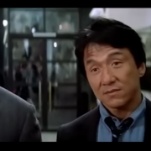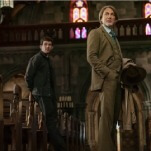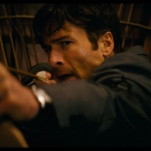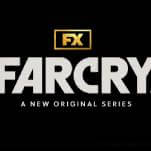Before Stanley Kubrick became an inscrutable master of world cinema, he was just another New York artist/hustler, trying to scrounge out a living from his interest in photography and movies. Kubrick got himself a job with Look magazine while he was still a teenager, then taught himself how to shoot motion pictures cheaply when he was in his early 20s, so that he could sell his services to a newsreel company. Then in 1952, Kubrick made his first fiction feature, the hourlong Fear And Desire, using money he raised from his family. The ponderous war movie—written by future Pulitzer Prize winner Howard Sackler—impressed a few major critics and was picked up for theatrical distribution in 1953, but neither Fear And Desire nor Kubrick’s 1955 independent feature Killer’s Kiss made much money or drew much attention, and after Stanley Kubrick became “Stanley Kubrick,” he often discouraged fans from seeking out his early work, saying that the 1956 heist thriller The Killing was his real debut. In fact, for a long time, Fear And Desire was impossible to see, reportedly because Kubrick himself refused to let it be screened publicly or released on home video. And even once the film’s copyright expired (and Kubrick lost control of its exhibition), prints were rare. Finally, a good copy of Fear And Desire was located and restored by The Library Of Congress, and now the film has arrived on Blu-ray.
Was Kubrick right to be embarrassed by Fear And Desire? Yes and no. It is an amateurish work in a lot of ways. Paul Mazursky (yes, the filmmaker) plays a mentally unstable soldier who’s trapped behind enemy lines with three of his comrades, who plan to float downriver on a raft and assassinate an officer. Along the way they attack a house occupied by enemy soldiers and lash a civilian woman to a tree, while Mazursky recites the plot to Shakespeare’s The Tempest and goes more and more insane. Fear And Desire suffers from some overwritten Sackler dialogue, and from Kubrick’s uncertainty with how to stage simple conversations. (That Kubrick had to bring his actors back in to re-dub all the dialogue didn’t help.) And it’s hampered by the filmmakers’ straining for profundity, exemplified by Kubrick having the “good guys” and the “bad guys” be played by the same actors, and by the script refusing to specify what war this is.
But there aren’t many other American movies from the early ’50s that can be accused of having too many ideas, as Fear And Desire can. Kubrick may have had trouble with the fundamentals of filmmaking, but that’s mainly because he was so eager to experiment. In one scene, he layers in a jumbled audio montage of the soldiers’ inner thoughts while they hike; in another, he recaps the events of the movie in quick-cut clips superimposed over shots of Mazursky and the captured woman.
Though much of the movie is either stiff or overwrought, Kenneth Harp does gives a wonderfully wry performance as the loquacious leader of the band, prone to ironic comments like, “There’s nothing so refreshing as an afternoon out-of-doors in enemy territory.” And Kubrick captures a few images—like one of a soldier gulping down cold stew while surrounded by corpses, and another low-angle tracking shot of a soldier slowly paddling his raft—that show his natural filmmaking instincts already at work. Fear And Desire is undeniably a Stanley Kubrick film, and not just because it includes a shot where Mazursky looks up at his own eyelids (a common Kubrick-character expression), and a set that resembles an early version of Dr. Strangelove’s shadowy, glowing War Room. No, it’s Kubrickian mainly because it intends to set a mood and convey information in ways that make audiences say, “Well, that’s new.”
Key features: The Kino Blu-ray contains no featurettes, no commentary, and no liner notes, but it does add Kubrick’s 1953 half-hour documentary The Seafarers (made on behalf of the Seafarers International Union), which consists mostly of ennobling color shots of merchant seamen taking advantage of the many benefits of union membership, from camaraderie in the recreation hall to the right to be heard at fully democratic meetings. Though Kubrick reportedly took the job just to raise some cash after the commercial washout of Fear And Desire, The Seafarers is still stirring enough to make any viewer want to hop in a time machine and give a year’s worth of dues to the SIU.








































